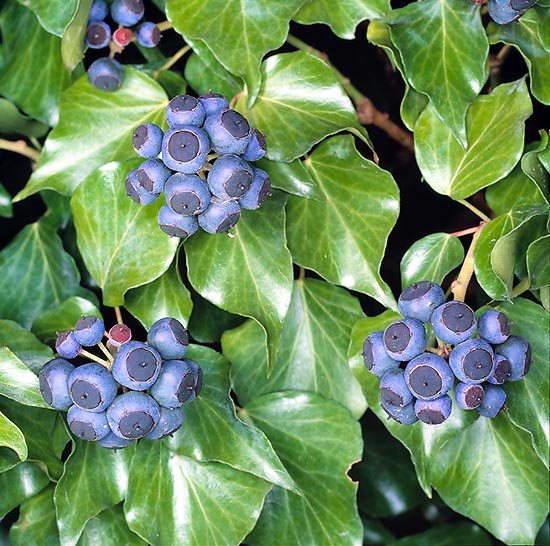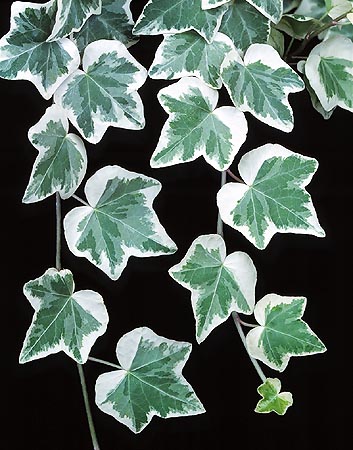Family : Araliaceae

Text © Pietro Puccio

English translation by Mario Beltramini

The fruits, loved by birds, are 6-8 mm berries. Medicinal virtues © Giuseppe Mazza
The name of the genus is the Latin one with which this plant, sacred to Bacchus, was called and with which the poets were crowned; the Latin name of the species, “helix” = helix, spiral, other name of Greek origin, refers to the way the plant winds round the trees or other supports, or to the habit of the Bacchus disciples had to wreathe their heads with ivy shoots, in the Latin mythology, and of Dionysus followers in the Greek one.
Common names: “common ivy”, “English ivy”, “Italian ivy”, “ivy”, “poet’s ivy”, “yellow-berry ivy” (English); “lierre grimpant” (French); “edera” (Italian); “hera”, “heradeira”, “hereira”, “aradeira”, “hedra”, “hera-dos-muros” (Portuguese); “hiedra”, “yedra” (Spanish); “Efeu” (German).
Climber or evergreen creeper with woody stems rooting on the nodes, long up to 30 m, provided with adventitious radicles which allow the stems to adhere to vertical surfaces, it has the phenomenon of the heterophylly (presence on the same plant of leaves with different shape) in correspondence with the two stages of growth, the young one, sterile, which can last 10 and more years, creeping or climbing, with tri- or penta-lobate leaves, 4-10 cm long and broad, of a dark green colour, leathery and glossy with pale green venations, and the adult one, fertile, with erect stem and ovate or rhomboid simple leaves.

Several much decorative horticultural varieties © G. Mazza
It easily reproduces by seed, which must be scarified in order to allow its germination, being covered by a hard tegument (in nature, this is replaced by the passage in the digestive apparatus of several species of birds which nourish of the fruits), and by portions of stem which easily root even in water; the apical cuttings of the adult plants maintain this characteristics and go on in growing as bush or as a small tree. The plant is very variable and many cultivated varieties come from natural mutations.
Very rustic plant, adaptable to an ample variety of soils and climates, as shown by its wide origin area; the best exposition is the semi-shaded one, but it adapts well also to the full sun.
When in pot, it needs a good draining, regular watering in summer and moderate in winter and a luminous position, particularly for the variegated leaf varieties, and well ventilated. All the parts of the plant, especially the fruits, contain toxic substances, in particular, saponins, between which the hederin, a powerful irritant for the mucosae of mouth and nose, and polyacetylenic compounds, which, on the contrary, if in the proper dosages, have pharmacological properties.
Synonyms: Hedera poetica Salisb. (1796); Hedera poetarum Bertol. (1827).
→ To appreciate the biodiversity within the ARALIACEAE family please click here.
